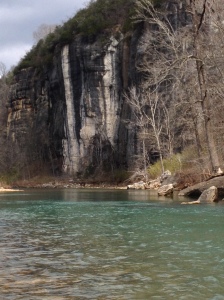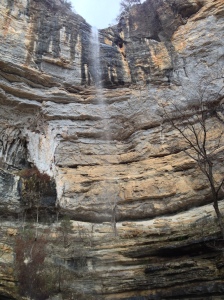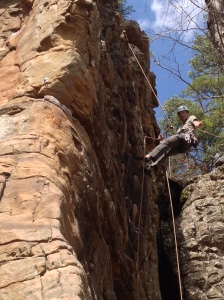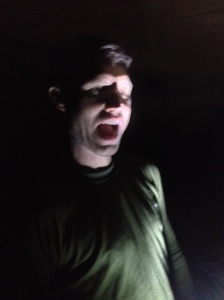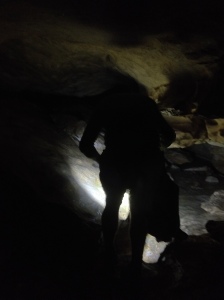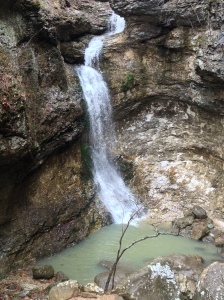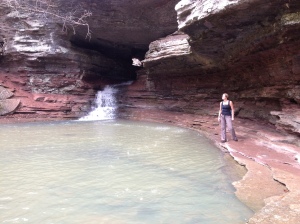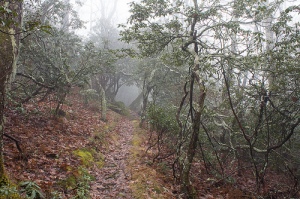What is it about extreme sports and injuries? It seems they go hand in hand, and don’t they always seem to happen at just the wrong time? Or do they happen at just the right time? Sometimes we learn things from our injuries and sometimes the lessons do not set in and we have to get injured again to really make it stick. In the end though, life has a funny way of repeating circumstances until the lessons truly take hold. Every time I get injured, I ponder all these questions, and I go through a range of emotions from anger to guilt to finally acceptance. Acceptance is the hardest one, and it takes a lot of introspection, but it usually comes. So first, I want to catalog all my major injuries and then I will talk about what I learned in the process.
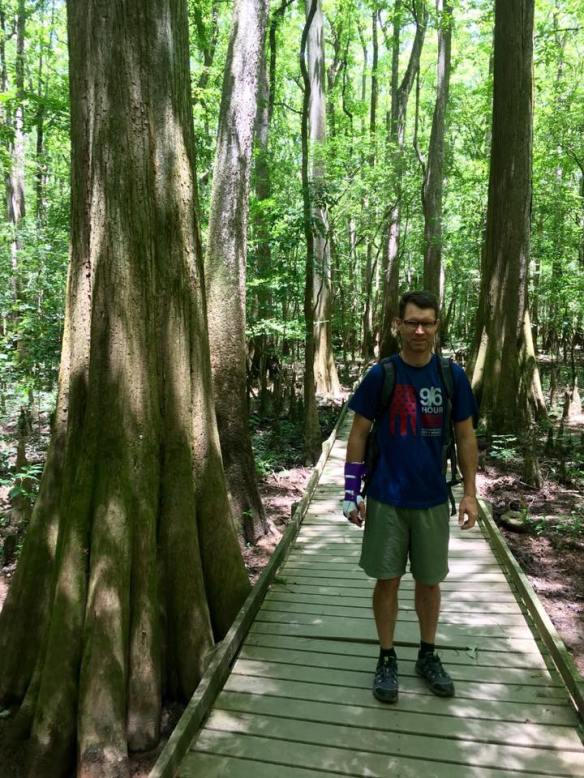
Hiking in Congaree National Park, SC.
My first really big injury was in 1990. It almost killed me. I was a young mountain sport enthusiast, living in Gunnison, Colorado. I was skiing every sick line I could find, jumping off big cliffs at Crested Butte, and skiing crazy shoots and trees 100+ days a year. I was kayaking every river I could find a shuttle to, biking every trail in the area from Gunnison and Crested Butte to Moab and Fruita. I was rock climbing every rock face I could find, and basically living the mountain lifestyle dream of doing everything related to mountains and doing it with wholehearted abandon. The adventures were always epic, and I do not regret the fast and crazy living of the Gunnison Valley, but did I mention that I was young and inexperienced? When you are young, you don’t have a healthy respect for fear, and you basically huck yourself into every situation without much thought about the consequences. When you are 20, you don’t realize that rocks can hurt and they can even kill. So that Fall season, we had gotten a lot of early season snow for about two weeks and the powder gods were dumping the area with tons of snow. We decided to hike for some turns on Crested Butte Mountain before it was open and we were treated to the best powder day I have ever experienced. It was literally chest deep and some of the best light and fluffy snow I have ever skied. We had been doing laps on some of the front side runs mid-mountain and during the last run, we were slowly making our way down the mountain. They had cut a new black run on the front side of the mountain and we wanted to check it out. Apparently, the stumps were not yet completely cleared out on that section. I noticed a few strands of long grass sticking out of the snow, but I figured we would be all right and I dropped in. I made three turns, caught a tip and went down on my side, right into one of the hidden tree stumps. In my inexperience, I did not realize that the early season snow had not set up an adequate base layer yet, and so we were basically skiing right above the rocks. It was fine up higher, but not down lower in the valley. Stumps do not mix well with ski tips, even if you are not going fast. I went down and did not hit hard, but the wind was immediately knocked out of my chest and I was in a lot of pain on my side and gut. I caught my breath, but was still having excruciating pain like a knife cutting into me with each breath I took, so I decided I needed to get out of there and find some help. Each breath and every bump on the way down felt like hell-fire and I was about to pass out from the pain. Something was wrong. At the bottom of the mountain, I laid down for a minute, while my friend went to get the van. Luckily, he was not able to hike up to where the van was because he had on old Sorrell boots that were terrible for hiking uphill. I wanted to lie there for awhile, but he sensed something was wrong. He came back to where I was and immediately got me up and we stumbled to the nearest clinic in Crested Butte. I started to knock on the door and the door opened simultaneously. The only paramedic in town was literally on his way to the store and we surprised him. If I had been a minute or two later he would have been gone, and I found out later I would not have made it to hospital in time, which was 30 minutes down the road in Gunnison. We went inside, took x-rays and determined I had two broken ribs. I was getting very dizzy and was about to lose consciousness, so the paramedic called an ambulance and we set out to the hospital. He got an IV in me and it turns out that is what saved my life. If I had driven on my own, I would not have made it. We made it to the hospital in Gunnison. They put a catheter in me and it was all blood. They did an exploratory surgery to see what was going on inside. The broken ribs had punctured my kidney and I was bleeding internally. The doctor thought it was not that bad and it would seal up on its own, so I sat in the hospital for a week with no progress. Each day I kept bleeding out a small amount of blood in my urine. A week later they sent me to Montrose, Colorado to have a MRI. The doctor there said I needed emergency surgery to repair the kidney. So they sent me to Denver General to a kidney specialist and he repaired the kidney the next day. Two days later the stitches broke and I had to have a second surgery. After about three more weeks of recovery, I finally was released from the hospital. Later, I went to retrieve my skis from the clinic in Crested Butte and met the guy who saved my life. He said I could have died from that injury and I was lucky to be alive. I thanked him and we talked a lot about the thin line of life and death. So as you can see, that day gave me a new-found sense of life and purpose, and I gained a new sense of the fragile nature of life. I decided I needed to slow down a little and think about things more before jumping in head first. In one quick moment, I was given a glimpse of the transient nature of life and it woke me up. I was thankful to be alive and it gave me a new sense of being thankful for every breath and every moment. I vowed to cherish life more and to live life with more purpose and direction. I would still ski, bike, climb and kayak, but now I would have a better sense of respect for possible injuries and I would listen to my gut instinct more when it said to back off. I was learning to turn off the ego, and to live for my own joy and not to impress others. When you are young, you sometimes do things so others will be impressed and my competitive nature always drove me to do better and to go bigger than someone else and to do it faster, etc. I was now realizing the futility of ego and I was learning to live for my own goals and aspirations. Who did I need to impress? Who cares what others think? In sport, you have to do things for your own joy and passion. When you can do that and learn to live in the moment, you are free to pursue sport for the sake of sport and you learn to push yourself in ways you never realized were possible.
My next injury was many years later and it was a big one too. I was rock climbing one day on a two pitch route in North Carolina at the Looking Glass called Rat’s Ass.

Climbing the super classic finger crack Shredded Wheat 5.11
After the first pitch, I had set up a hanging belay in a crack and brought my wife Shannon up to the stance. I had noticed a shooting pain in my lower back and it was killing me. We finished the day and I went home and took some Ibuprofen to help with the shooting back pain. It never went away and for the next month, every time I was standing, sitting, or walking, I was in intense pain. The pain radiated down my leg and and was debilitating. The only time it did not hurt, was when I was laying in the fetal position in bed. I had been getting massage and adjustments at a Osteopath for a while and the pain would go away for a day, but it would come back with a vengeance. The Osteopath finally ordered an MRI and gave me a diagnosis of a slipped or herniated disc. A lifetime of skiing bumps and hard mountain living had finally caught up to me. Surgery was the only option, so I traveled to Dallas, Texas and had surgery with a neurologist friend of my dads. Two hours after the surgery, I was pain-free and I walked out of the hospital. The laminectomy/dissectomy surgery was a complete success. The doctor said I could not rock climb for three months, and at the time I was a complete climbing addict. What was I going to do? How could I not climb for 90 days? At first I was super depressed and angry. I got bored very quickly as well. The doctor said to walk as much as possible for therapy, so I started hiking more. Slowly, my mental state started to change. I went to some amazing places in North Carolina and started hiking a few 6000 foot peaks.

The ridge to Plott Balsam
I discovered a hiking program called SB6K, which stands for South Beyond 6000. SB6K is a hiking challenge to hike all the states 40 peaks over 6000 feet. There are actually 60 peaks, but some are just sub-peaks of other peaks. I completed the program a year later and that was one of the most meaningful and tough projects I have ever completed. For a full write up of that experience, see my post Bushwhacking in High Places. In the end of that experience, I discovered that life can show you many beautiful things if you take the time to find them and step out of your comfort zone and try new things. The back injury forced me to stop climbing, and I learned to climb in new ways, through hiking. I saw places of beauty during that summer that I cannot describe, and I learned more about perseverance and overcoming great odds in three months than I had in all my entire life. I learned patience and how to wait for things. After three months I started climbing again, and the lessons I learned during that time helped my climbing tremendously. I learned to wait for the right moment, and I learned that injuries get better when the time is right. I learned that not doing your main passion all the time opens other doors of learning and opportunities that are sometimes hidden. Once again I learned about moderation and managing risk. I would still climb, but I would do it smarter and in ways that did not tax my back so much. I learned to respect my body and to cherish it for what it is, a medium through which I discover beautiful things and places in the world. I needed to take care of my body and slowing down is always a good thing for your body. I did not stop, I was just more mindful and not as careless.
My next injury was tearing my glenoid labrum joint in my shoulder while bouldering at the climbing gym. I had been pushing it really hard and completed a strenuous problem, but in an instant of ego, I dynoed to a higher hold to show I could do a hard problem, plus one more move. The instant I lunged for the hold I heard and felt the click, which signaled the tear of my shoulder. I instantly had a shooting pain all through my arm and knew I injured it. I rested for about a week and it still hurt bad, so I finally went to the doctor. He ordered a MRI and yes, I tore the joint. It would never completely heal, but he did say to rest for a while and see what happens. I did not climb for a month. He said to go out and test the waters so to speak. I went out and climbed on it. It seemed fine, so to this day, I still climb on it and never got surgery. I just have to be aware of it and not overly exert the shoulder too much. I can still climb hard, but I have to use my feet more and push through moves instead of yank hard on my shoulder or do a crazy dynamic move on the shoulder. So once again, the lessons were moderation and control. I learned to have control of my body to not flail around on climbs haphazardly and jump for holds. I learned to control my mind to not over do it when I might want to do “one more route before we go”, and most of all I learned to control my mind and let it go and relax in situations that might be stressful. I have learned to be in the moment more and to take things for what they are now. If I fail at a route and it is too hard, it is all right and I know I tried my best. At least I am still out there giving it a go. I do not have to be the best and I do not have to do every route, but I still get out there and do it.
Last year I was injured hiking. That injury was pretty funny actually, because I got hurt trying to help a dog get a ball out of the river. My wife and I used to walk a husky for extra money twice a week. That day we went on one of our favorite hikes to a local waterfall in Montreat College. Finn, the dog we walked, loved the water and he loved tennis balls and chasing them. He just did not really understand the art of fetching.

Finn the dog
He would do it sometimes, but most of the time he would only bring back the ball half way, or he would drop it in the river, like he did that day. I threw the ball and he chased it and brought it back half way and it rolled back into the river. Slowly it tumbled down to a lower pool in the river. He would not get it and so dumb me went for it. I started to walk towards the slanting, slick wall of rock near the water and slipped. I tried to run it out, fell and almost made it, but hit my hand hard on the rocks and severely dislocated my ring finger. I had to get stitches and luckily I got my wedding ring off before the major swelling started. They later numbed my hand and finger with Novacaine and set it back in place. The shots on my finger and hand they gave me really hurt by the way. Have you ever had a shot right in the sensitive nerves of your fingers and hand? Yes, it burns like fire and feels like someone is grinding your hand with a meat cleaver. It is now a year and a half later, and I still have a swollen knuckle on my finger. I can get my wedding ring on and off if I put baby oil on it. At least I still have complete range of motion and I can still ride and race my bike and run my guide service I started called Pisgah Mountain Bike Adventures.

Firetower in The Buffalo National River trails, AR.
So through this injury, I learned that even simple outings can become dangerous and if you let your guard down, even for a moment, things can happen that you do not expect. I was not thinking and went down the steep, wet slope towards the water just to get a tennis ball. I let my guard down and fell on a slope I knew not to tread on, but I did anyways in a momentary lapse of judgement. After this experience, I learned to slow down and evaluate situations, even simple ones, for objective hazards, and think before you act. One of the best lessons I learned from rock climbing that could be applied here, is to think of a challenge and fear of the unknown as a bubble. You have a circle around you at all times. If you stay in the circle, you stagnate and never grow. To grow, you must step out of the circle and push through your fear. You see the fear or objective danger for what it is, you evaluate all the hazards, you look at your abilities and know you are capable of doing a move, and then you decide to move forward. You do not do it recklessly, but in a controlled manner. You see the fear and danger and you push it aside for a moment and not let it paralyze you, and you move forward. In that way, you learn to have a healthy respect for the fear or challenge, and for the time you move through it and push it aside. In that way it does not control you and you learn to use it to grow and challenge yourself in new ways. You go outside that bubble and you make it safely to the next hold and you realize you can do it. In that way our fears are there to help guide us though the challenge and in the end it is our mind that breaks though the challenge. If I would have slowed down and looked at that ball and saw the danger of the steep, wet slope, I could have made a better plan to crab crawl down the slope or find an easier way around. I let my mind get clouded by the reward of getting the ball fast and I slipped and screwed up my hand. Once again, lessons through injuries.
Now we come to the present. Four weeks ago, I was biking and crashed hard in a rock garden and fractured my fifth metacarpal in my hand and got six stitches in my arm. The doctor this time said no biking for six weeks. I am four weeks out and I am finally starting to get range of motion back in my hand and fingers and it is healing great. I have been hiking a good bit again, bagging summits from the SB6K program again, and I am in a pretty good space right now emotionally. For the past year I have been biking really hard and the month before my injury, I had really been pushing it and exploring new trails I had never been on before. I was getting a little too comfortable with fast riding and taking things for granted a bit as far as health and injury. It is funny how your brain shuts out that part of life. I had been riding solo a lot before the injury and I was really feeling confident and dare I say a tad bit invincible? Then bam, I hit a tree with my bar, right at a serious rock garden, and go into the rocks way off-balance trying to recoup. The first rock my front tire hits sends me flying over my handlebars. I fly off the trail and land 15 feet off the trail straight on my arm on solid, sharp rocks. Blood is gushing everywhere and I was a little worried at first. I move my fingers and they seemed all right. It hurt, but not that bad. I thought I just jammed my finger, no big deal. After a few minutes, the blood stops gushing, and so I bike the mile back to the road, holding on with two fingers since my fingers hurt a bit when I put pressure on them. I walked any technical section and rode the rest. I made it to the road and coast two more miles to where Shannon had waited for me after our earlier ride together on the first loop. I did a second loop solo of course, and that was the new to me technical loop. What could possibly happen I thought earlier? I will be fine I told her. I guess I was a little off that day, because I crashed three times that day, once on an uphill fire-road even. Who knows? I came up to her and said I think I need to go get some stitches, since I had a pretty big gash on my arm. At the urgent care in Asheville, I learned I did indeed fracture my hand. Crap, here we go again.
I have been thinking a lot about this hand injury and what it means. I have tried to stay positive this time and for the most part I have done well with this part. It could have been much worse and I feel lucky that it was not my head or that I did not break any other major bones like my arm or leg. This time I learned to be thankful for what I do have. For two weeks I could not use my hand and that was a challenge. Actions you take for granted like showering or brushing your teeth, getting dressed, writing, etc., were impossible to do alone. Shannon had to help me wash my arm pits and help me get dressed. Luckily, we have a bidet in the bathroom. Even my wife draws the line at times. Slowly, I started to adapt and learn to do those things on my own. I got pretty good at typing left-handed, showering and brushing my teeth. In the process, it taught me to be truly thankful for health and simple things like grabbing an object, or writing my name on a paper. Now I am typing with my right hand and I am getting better range of motion each day. I learned to not take health for granted and I learned to be grateful for the little things. I know it will heal, it will just take a little time. In the big scheme of things, six weeks is nothing and it could have been much worse and I feel truly grateful that I will make it and live to ride again.
It is really hard to see events and circumstances just as they are and not have negative reactions to those things or events. When we can do that, we learn to control how we react to situations and we take them for what they are in the moment, namely learning experiences. We learn to regulate our emotions and not be attached to outcomes or controlling things that are out of our control. We then are free to be happy in the moment and learn from the experience and not brood over things. All these experiences have been hard, but I have tried to stay positive and learn from the experiences. In the big scheme of things, 6 weeks, 3 months or a year and a half is nothing, and all these injuries could have been much worse and I feel grateful for that fact. Injuries are great teachers. You just have to look hard for the silver lining. “Healing is a matter of time, yet it is also sometimes a matter of opportunity.”

